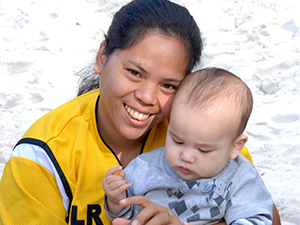More fun with playdough – Baby
 Older babies may become interested in playdough.
Older babies may become interested in playdough.
As they often put things in their mouth, close supervision is needed during play. Touching, feeling and talking about textures & colours are all ways of engaging your baby. This exposes them to language and different sensory experiences.
Did you know?
Older babies love to imitate, so when they see others with playdough of course they want to join in! Simple actions such as poking and pressing are fun ways to get little hands active and build up hand strength.
Add language
Talking to your baby about what they are touching and feeling helps them to focus on their actions and hear words that match what they are doing. For example, “Ooh, soft” or “Oh, you’re pushing” or “pat, pat, pat”.
Other development
At this age, babies are learning they can make things happen (known as cause and effect). When your baby pokes or pushes playdough, they see the mark they made. This helps them realise the effect of their actions.
Variations
Why not try a salt-free dough recipe using flour, oil and water? This would be safer for your baby if they tend to eat the playdough.
Some other safe, sensory play for babies can include; food-play (when your baby can sit up), tummy-time on a different surface (e.g. grass), and sealed plastic sensory bottles provide safe, mess-free sensory fun (these can be found by internet search: sensory bottles)
Safety
Homemade playdough is safe to eat although discourage children from consuming large quantities.
Here is a quick easy recipe which keeps well in the fridge for months:
Making Playdough
Ingredients
1 cup salt
2 cups plain flour
2 tablespoons oil
3 teaspoons cream of tartar
2 cups boiling water
colour if required
Method
1. Combine ingredients (except water) in a bowl.
2. Pour the boiling water and stir.
3. Knead lightly on table top.
Or watch our video on how to make it here.

